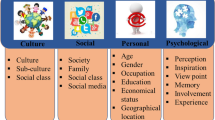Abstract
In the conceptual design stage, outcomes of industrial designers work are generally represented by set of sketches where curves, notes, shadows, and colors implicitly represent creative ideas. Signs and annotations are used to synthesize and concretize the design intent that, finally, will be transformed into the styling product visual appearance. The loss of the original design intent may be due to the complexity of the design process, and the involvement of different actors. Our aim is to provide a method and relative tools in order to interpret signs on sketches for eliciting the design intent. The analysis result is a set of aesthetic features that can be used for driving CAD modeling, in the case both of Reverse Engineering applications and of product modeling for restyling purposes. Sketches analysis is based on a semiotic interpretation driven by the formalization of the cognitive models used in the conceptual design phase. The approach showed promising results on different styling products test cases.









Similar content being viewed by others
References
Catalano CE, Falcidieno B, Giannini F (2004) Introduce sweep features in modeling with subdivision surfaces. J WSCG 12(1):81–88
Chalechale A, Naghdy G, Mertins A (2005) Sketches-based image matching using angular partitioning. IEEE Transactions on Systems, Man and cybernetics: part a: systems and humans 35(1):57–66
Chandrasekaran B (1999) Multimodal perceptual representation and design problem solving. In: Proceeding of visual and spatial reasoning in design: computational and cognitive approaches, Cambridge, MA
Cheutet V, Catalano CE, Pernot JP, Falcidieno B, Giannini F, Leon JC (2004) 3D Sketching with fully free form deformation features (δ-F4) for aesthetic design. In: Hughes JF, Jorge JA (eds) Proceedings of EUROGRAPHICS workshop on sketch-based interfaces and modelling, Grenoble, France, pp 9–18
Cross N (1997) Descriptive models of creative design: application to an example. Des Stud 18:427–455
Dorst K, Cross N (2001) Creativity in the design process: co-evolution of problem-solution. Des Stud 22(5):425–437
Ferguson ES (1992) Engineering and the mind’s eye. MIT Press, Cambridge
Fontana M, Giannini F, Meirana M (2000) Free form features for aesthetic design. Int J Shape Model 6(2):273–302
Germani M, Mandorli F (2004) Aesthetic design: a methodology to preserve the stylist intent using digitised models. In: Horvath I, Xirouchakis P (eds) Proceedings of international symposium on tools and methods of competitive engineering, Lausanne, Switzerland, pp 131–141
Gero JS, Kannengiesser U (2004) The situated function-behaviour structure framework. Des Stud 25:372–391
Goel V (1995) Sketches of thought. MIT Press, Cambridge
Goldschmidt G (2001) Visual analogy: a strategy for design reasoning and learning. In: Eastman CM, McCracken WM, Newstetter WC (eds) Design knowing and learning: cognition in design education. Elsevier, Amsterdam, pp 199–220
Gross MD (1994) Recognizing and interpreting diagrams in design. In: Proceedings of advanced visual interfaces, Bari, Italy, pp 88–94
Hofstadter DR (2001) Analogy as the core of cognition. In: Gentner D, Holyoak K, Kokinov B (eds) The analogical mind: perspectives from cognitive science. The MIT Press/Bradford Book, Cambridge, pp 499–538
Kavakli M, Gero J (2001) Sketching as mental imagery processing. Des Stud 22(4):347–364
Ke Y, Fan S, Zhu W, Li A, Liu F, Xiquan S (2006) Feature-based reverse modeling strategies. Comput Aided Des 38:485–506
Langerak TR, Vergeest JSM (2006) A new framework for the definition and recognition of free form features. In: Horvath I, Rusak Z (Eds) Proceedings of the International Symposium on Tools and Methods of Competitive Engineering, Ljubljana, Slovenia pp 359–370
Langerak TR, Vergeest JSM (2007) Feature recognition of user-defined freeform features. Comput Aided Des Appl 4(1–4):529–538
Lawson B (2006) How designers think. Architectural Press, Oxford
Mengoni M, Mandorli F, Germani M (2006) Surface reconstruction method for reverse engineering based on aesthetic knowledge. In: Horvath I, Rusak Z (Eds) Proceedings of the international symposium on tools and methods of competitive engineering, Ljubljana, Slovenia, pp 251–262
Mengoni M, Germani M, Mandorli F (2007) Reverse engineering of aesthetic products: use of hand-made sketches for the design intent formalization. J Eng Des 18(5):413–435
Norman DA (2004) Emotional design: why we love (or hate) everyday thing. Basic Books, New York
Rodgers PA, Green G, McGown A (2000) Using concept sketches to track design process. Des Stud 21:451–464
Schutze M, Sachse P, Romer A (2003) Support value of sketching in the design process. Res Eng Des 14(2):89–97
Sequin CH (2005) CAD tools for aesthetic engineering. Comput Aided Des 37:737–750
Suwa M, Tversky B (1997) What architects and students perceive in their sketches: a protocol analysis. Des Stud 18:385–403
Thompson WB, Owen JC, De St.Germain HJ, Stark SR, Henderson TC (1999) Feature-based reverse engineering of mechanical parts. IEEE Trans Rob Autom 15(1):57–66
Tovey M, Porter S, Newman R (2003) Sketching, concept development and automotive design. Des Stud 24(2):135–153
Ullman DG, Wood S, Craig D (1990) The importance of drawing in the mechanical design process. Comput Graph 14(2):263–274
Van Dijk CGC, Mayer AAC (1997) Sketch input for conceptual design. Comp Ind 34:125–137
Vergeest JSM, Song Y, Langerak TR (2006) Design intent management for design reuse. In: Rohatynski R, Poslednik P (Eds.) Proceedings of the Design Methods for Practice. Zielona Gora, Polonia pp 163–170
Author information
Authors and Affiliations
Corresponding author
Rights and permissions
About this article
Cite this article
Mengoni, M., Germani, M. Reverse Engineering and restyling of aesthetic products based on sketches interpretation. Res Eng Design 20, 79–96 (2009). https://doi.org/10.1007/s00163-008-0054-1
Received:
Accepted:
Published:
Issue Date:
DOI: https://doi.org/10.1007/s00163-008-0054-1




